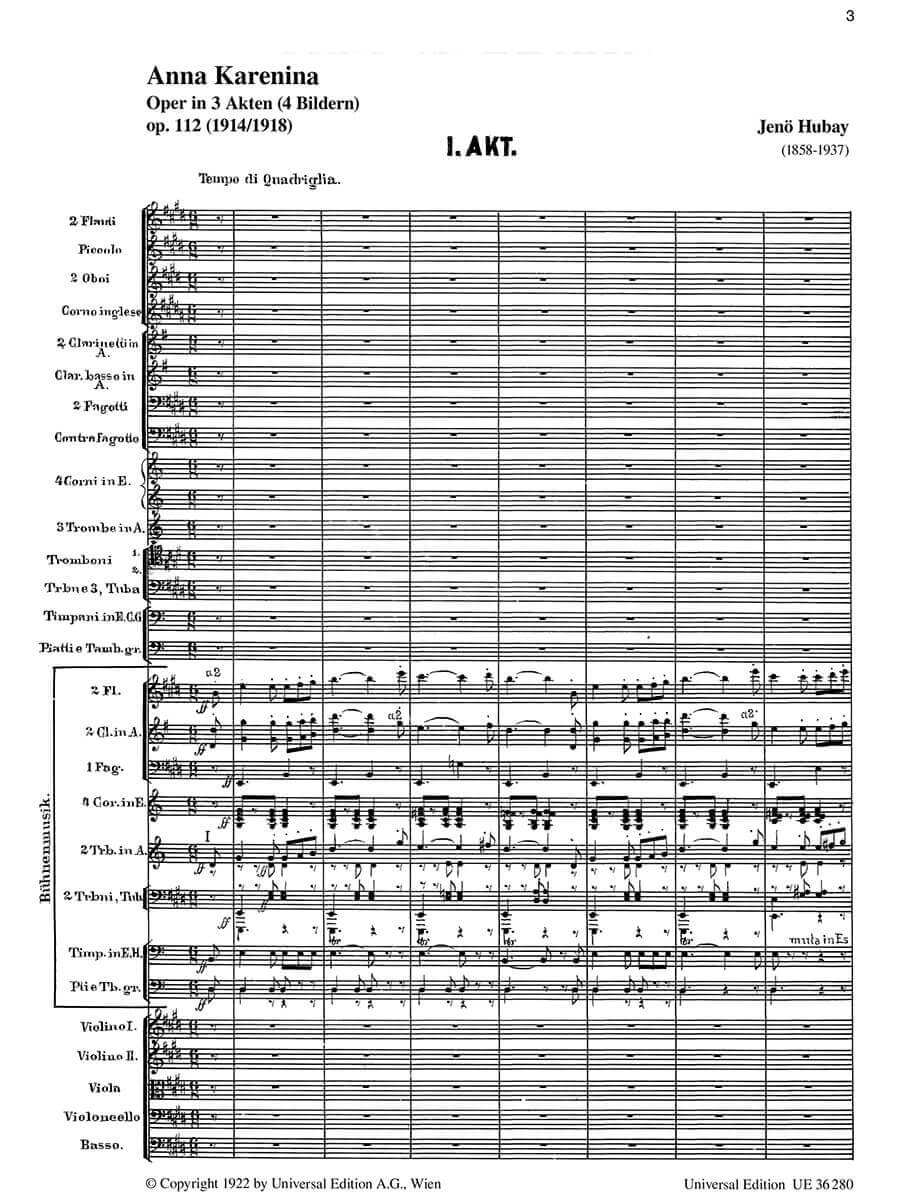Anna Karenina Op. 112 (with German libretto)
Hubay, Jenö
70,00 €
Preface
Jenö Hubay
(b. Pest, 15 September 1858 – d. Budapest, 12 March 1937)
Anna Karenina, op. 112
(1914-18)
Opera in three acts
after the like-named novel by Leo Tolstoy
Preface
Jenö Hubay – or, to use the name on his birth certificate, Eugen Huber – was a towering virtuoso violinist in a generation that included the great Pablo de Sarasate and Eugène Ysaÿe. A pupil of Joseph Joachim in Berlin, he attracted the attention of Henri Vieuxtemps during a dazzling series of concerts in Paris that made him the darling of the salons. Vieuxtemps formed a friendship with him and fetched him to the Brussels Conservatory, where Hubay succeeded him as principal violin professor in 1882, making him effectively the head of the Franco-Belgian school of violin playing at the age of twenty-four. Six years later he was recruited as violin professor at the newly founded National Conservatory in Budapest. He remained there to the end of his days, serving as the Conservatory’s director from 1919 and turning out a large number of outstanding pupils whose names resonate throughout the twentieth century: Joseph Szigeti, Jelly d’Aranyi, Steffi Geyer, André Gertler, Eugene Ormandy, Franz von Vecsey, and Sándor Végh, to name only a few. He also married into the aristocracy in 1894, and was himself awarded a patent of nobility in 1907, which allowed him to bear the nobiliary particle “von” and to style his name Eugen von Hubay. His palace in Budapest became a favorite meeting place for Hungary’s artistic and intellectual elite, and he acquired something of the aura of a cultural figurehead for the Kingdom of Hungary.
None of this will be unfamiliar to connoisseurs of the violin, and it dominates the entries on Hubay in the standard lexica. What is less well-known, however, is that he also found time to produce a voluminous body of compositions, including not just the usual concert-études and recital pieces customarily turned out by violin virtuosos, but three massive choral-vocal symphonies and, of greater interest to us here, nine operas, of which one, the comic A Cremonai hegedűs (The Violin Maker of Cremona, 1894), achieved the notable distinction of being the first Hungarian opera to be exported abroad.
Anna Karenina – or Karenina Anna, to quote its original Hungarian title – was Hubay’s eighth opera, and it originated while the composer was at the zenith of his fame. The libretto, after Leo Tolstoy’s immortal novel of the same title, was written by Sándor Góth and Andor Gábor, who had the advantage of basing their text on a five-act French stage adaptation by Edmond Guiraud that deftly digested Tolstoy’s 1000-page novel and enjoyed a successful run in Paris in 1907. Thus shorn of the novel’s many subplots, ancillary characters, and portraits of nineteenth-century Russian society, the libretto concentrated entirely in the love tragedy of Anna and Vronsky, which placed it well within the verismo purlieus of Puccini, d’Albert, Leoncavallo, and Mascagni so popular on the operatic stage at the time. Hubay began work on the composition manuscript in early 1914 and completed it on 22 July 1914, just in time for the outbreak of the First World War. Although there was little hope for a performance during those troubled times, he continued to work on the orchestration during the war years and completed the full score on 18 July 1918…
Read full preface > HERE
Score Data
| Edition | Opera Explorer |
|---|---|
| Genre | Opera |
| Size | 225 x 320 mm |
| Printing | Reprint |
| Pages | 428 |
